!-! Getting Ready !-!
If you are in a wooded or brush-covered area, clear the brush and scrape the
surface soil from the spot you have selected. Clear a circle at least 1 meter in
diameter so there is little chance of the fire spreading. If time allows, construct
a fire wall using logs or rocks. This wall will help to reflect the heat where
you want it. It will also reduce flying sparks and cut down on the amount of wind
blowing into the fire. However, you will need enough wind to keep the fire burning.
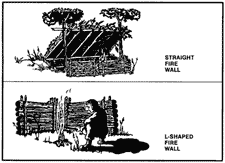 CAUTION: Do not use wet or porous rocks as they may explode when heated.
CAUTION: Do not use wet or porous rocks as they may explode when heated.
In some situations, you may find that an underground fireplace will best meet
your needs. It conceals the fire and serves well for cooking food. To make an
underground fireplace or Dakota fire hole Dig a hole in the ground. On the
upwind side of this hole, poke or dig a large connecting hole for ventilation.
Build your fire in the hole as illustrated.
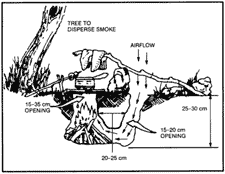
If you are in a snow-covered area, use green logs to make a dry base for your
fire. Trees with wrist-sized trunks are easily broken in extreme cold. Cut
or break several green logs and lay them side by side on top of the snow. Add
one or two more layers. Lay the top layer of logs opposite those below it.

!-! How To Build The Fire (not everybody knows how) !-!
There are several methods for laying a fire, each of which has advantages.
The situation you find yourself in will determine which fire to use.
- TeePee
- Lean-To
- Pyramid
- Cross-Ditch
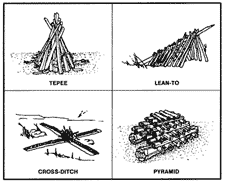 Tepee
Tepee
To make this fire arrange the tinder and a few sticks of kindling in the
shape of a tepee or cone. Light the center. As the tepee burns, the outside logs
will fall inward, feeding the fire. This type of fire burns well even with wet wood.
Lean-To
To lay this fire push a green stick into the ground at a 30-degree angle. Point the end
of the stick in the direction of the wind. Place some tinder deep under this lean-to
stick. Lean pieces of kindling against the lean-to stick. Light the tinder. As the
kindling catches fire from the tinder, add more kindling.
Cross-Ditch
To use this method scratch a cross about 30 centimeters in size in the ground. Dig the
cross 7.5 centimeters deep. Put a large wad of tinder in the middle of the cross. Build
a kindling pyramid above the tinder. The shallow ditch allows air to sweep under the
tinder to provide a draft.
Pyramid
To lay this fire place two small logs or branches parallel on the ground. Place a solid
layer of small logs across the parallel logs. Add three or four more layers of logs or
branches, each layer smaller than and at a right angle to the layer below it. Make a
starter fire on top of the pyramid. As the starter fire burns, it will ignite the logs
below it. This gives you a fire that burns downward, requiring no attention during the
night. There are several other ways to lay a fire that are quite effective. Your situation
and the material available in the area may make another method more suitable.
!-! How To Light The Fire (not everybody knows how to do that either) !-!
Always light your fire from the upwind side. Make sure to lay your tinder, kindling,
and fuel so that your fire will burn as long as you need it. Igniters provide the
initial heat required to start the tinder burning. They fall into two categories
modern methods and primitive methods.
Modern Methods
Modern igniters use modern devices items we normally think of to start a fire.
Matches
Make sure these matches are waterproof. Also, store them in a waterproof
container along with a dependable striker pad.
Convex Lens
Use this method only on bright, sunny days. The lens can come from binoculars,
camera, telescopic sights, or magnifying glasses. Angle the lens to concentrate
the sun's rays on the tinder. Hold the lens over the same spot until the tinder
begins to smolder. Gently blow or fan the tinder into flame, and apply it to the
fire.
Metal Match
Place a flat, dry leaf under your tinder with a portion exposed. Place the tip
of the metal match on the dry leaf, holding the metal match in one hand and a
knife in the other. Scrape your knife against the metal match to produce sparks.
The sparks will hit the tinder. When the tinder starts to smolder, proceed as above.
Battery
Use a battery to generate a spark. Use of this method depends on the type of battery
available. Attach a wire to each terminal. Touch the ends of the bare wires together
next to the tinder so the sparks will ignite it.
Primitive Methods
Primitive igniters are those attributed to our early ancestors.
Flint and Steel
The direct spark method is the easiest of the primitive methods to use. The
flint and steel method is the most reliable of the direct spark methods. Strike
a flint or other hard, sharp-edged rock edge with a piece of carbon steel
(stainless steel will not produce a good spark). This method requires a
loose-jointed wrist and practice. When a spark has caught in the tinder, blow on
it. The spark will spread and burst into flames.
Fire-Plow
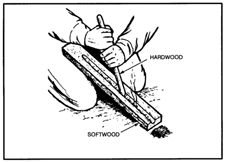
The fire-plow is a friction method of ignition. You rub a hardwood shaft against a
softer wood base. To use this method, cut a straight groove in the base and plow
the blunt tip of the shaft up and down the groove. The plowing action of the shaft
pushes out small particles of wood fibers. Then, as you apply more pressure on each
stroke, the friction ignites the wood particles.
Bow and Drill
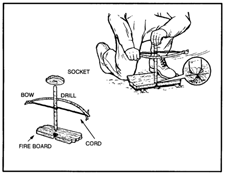
The technique of starting a fire with a bow and drill is simple, but you must exert
much effort and be persistent to produce a fire. You need the following items to
use this method:
Socket:
The socket is an easily grasped stone or piece of hardwood or bone with a slight
depression in one side. Use it to hold the drill in place and to apply downward
pressure.
Drill:
The drill should be a straight, seasoned hardwood stick about 2 centimeters in
diameter and 25 centimeters long. The top end is round and the low end blunt (to
produce more friction).
Fire board:
Its size is up to you. A seasoned softwood board about 2.5 centimeters thick and
10 centimeters wide is preferable. Cut a depression about 2 centimeters from the
edge on one side of the board. On the underside, make a V-shaped cut from the edge
of the board to the depression.
Bow:
The bow is a resilient, green stick about 2.5 centimeters in diameter and a string.
The type of wood is not important. The bowstring can be any type of cordage. You tie
the bowstring from one end of the bow to the other, without any slack.To use the bow
and drill, first prepare the fire lay. Then place a bundle of tinder under the V-shaped
cut in the fire board. Place one foot on the fire board. Loop the bowstring over the
drill and place the drill in the precut depression on the fire board. Place the socket,
held in one hand, on the top of the drill to hold it in position. Press down on the
drill and saw the bow back and forth to twirl the drill. Once you have established a
smooth motion, apply more downward pressure and work the bow faster. This action will
grind hot black powder into the tinder, causing a spark to catch. Blow on the tinder
until it ignites.
Hints and Tips
Primitive fire-building methods are exhaustive and require practice to ensure success.
Use nonaromatic seasoned hardwood for fuel, if possible.
Collect kindling and tinder along the trail.
Add insect repellent to the tinder.
Keep the firewood dry.
Dry damp firewood near the fire.
Bank the fire to keep the coals alive overnight.
Carry lighted punk, when possible.
Be sure the fire is out before leaving camp.
Do not select wood lying on the ground. It may appear to be dry but generally
doesn't provide enough friction.





